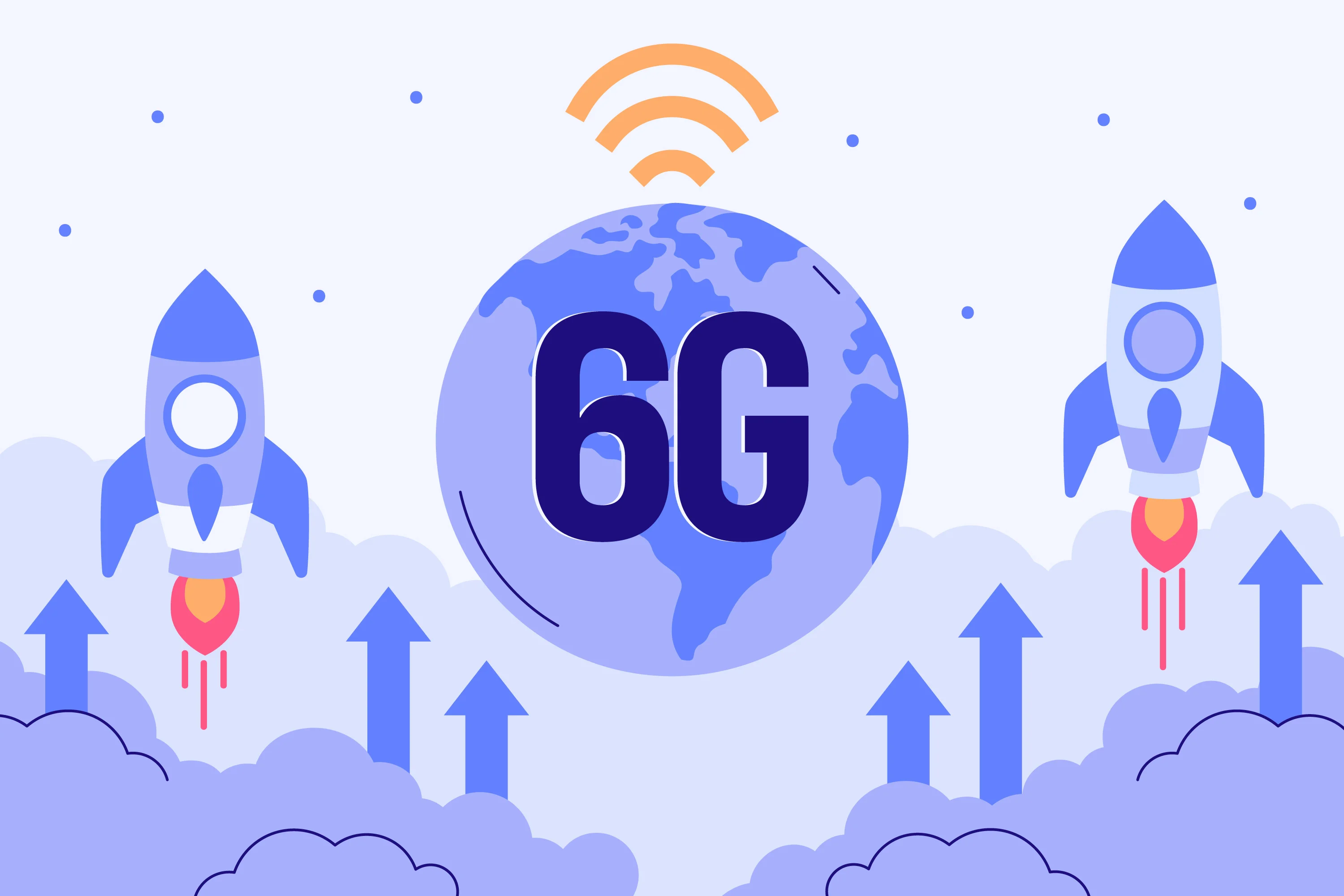Telecommunications seeks relentless next-gen network technology advancement. As 5G continues its transformative impact on connectivity, experts and industry leaders are already focused on the horizon: 6G. This impending revolution has the potential to reshape our connectivity experience, boasting faster speeds, reduced latency, and groundbreaking innovations.
In this blog post, we delve into the technological advancements necessary for 6G, the benefits and challenges it presents to consumers, and the key players fueling the ongoing development race. Brace yourself for a thrilling journey into the future of connectivity.
What Technological Advancements are Required for 6G?
-
Spectral Efficiency and Higher Frequencies
To achieve even greater data speeds and accommodate the exponential growth in connected devices, 6G will rely on higher frequencies than its predecessors. Millimetre waves (mmWave) and terahertz frequencies are being explored, enabling faster data transmission and larger bandwidths. Additionally, spectral efficiency must be significantly improved to optimise the use of limited spectrum resources, ensuring seamless connectivity for an ever-increasing number of users. -
Advanced Antenna Technologies
The development of 6G will necessitate cutting-edge antenna technologies, including massive MIMO (Multiple-Input, Multiple-Output) and intelligent beamforming. These technologies will enhance signal reliability, increase network capacity, and allow for better coverage in crowded urban environments, remote regions, and even underwater. -
AI-Driven Networks and Smart Resource Management
Artificial Intelligence (AI) will play a critical role in 6G networks. AI-driven systems will enable dynamic resource allocation, network optimisation, and predictive maintenance. By leveraging machine learning algorithms, 6G networks can become self-organising and self-healing, leading to more efficient operations and improved user experiences. -
Holographic Communication and Spatial Multiplexing
6G envisions a world where holographic communication becomes a reality. Spatial multiplexing techniques will allow multiple data streams to be transmitted simultaneously within the same frequency band, boosting network capacity and enhancing the way we interact and collaborate.
Benefits and Challenges Await Users in the Era of 6G
-
Enhanced Connectivity and Data Speeds
6G aims to deliver unprecedented data speeds, potentially reaching terabits per second. This speed will revolutionise the way we download and upload content, stream high-quality media, and experience virtual and augmented reality applications. -
Ultra-Low Latency and Real-Time Applications
6G’s ultra-low latency, with response times in mere microseconds, holds promise for real-time applications such as remote surgery, autonomous vehicles, and seamless augmented reality experiences. This breakthrough will create new opportunities across diverse industries, revolutionising the way we interact with technology. -
Internet of Everything (IoE) and Advanced IoT Applications
With the capacity to connect billions of devices, 6G will evolve IoT into IoE, driving advanced applications like smart cities, smart homes, and remote industrial monitoring. This transformation will foster a more interconnected and efficient global landscape, revolutionising how we interact with technology and enhancing various aspects of daily life. -
Enhanced Privacy and Security Measures
Anticipated as a solution to security concerns from 5G, 6G is set to implement stronger encryption, improved authentication mechanisms, and advanced cybersecurity measures. These enhancements will fortify user data protection, ensuring a safer and more secure network environment, thereby bolstering consumer confidence in the technology. https://www.freepik.com/free-vector/hand-drawn-6g-background_44955825.htm#
https://www.freepik.com/free-vector/hand-drawn-6g-background_44955825.htm#
Challenges
Despite its potential, the deployment of 6G will face various challenges:
-
Infrastructure Upgrades: The deployment of 6G will demand substantial infrastructure upgrades, entailing the installation of new base stations and equipment, potentially incurring considerable costs and time investments.
-
Spectrum Allocation: Allocating sufficient and suitable spectrum for 6G networks is a complex task, as the available frequency bands must be carefully managed to avoid interference and ensure seamless connectivity.
-
Energy Efficiency: The higher frequencies and complex technologies of 6G may result in increased energy consumption, making energy efficiency a key concern for sustainability.
-
Global Standardisation: Achieving global standardisation for 6G will be crucial to ensure compatibility and interoperability between networks worldwide, but it may require time and collaboration among different stakeholders.
Who are the Key Players in the 6G Development Race, and How Do They Compare?
-
United States
The United States, with companies like Verizon, AT&T, and Qualcomm, leads in 6G research and development. Major academic institutions and tech giants are actively involved, striving to uphold their position as global wireless technology leaders. -
China
China is resolute in securing a prominent position in the 6G race. With heavy investments in research and development from companies like Huawei, ZTE, and China Mobile, the nation receives substantial backing from government support and funding to stay at the forefront of technological advancement. -
South Korea
South Korea positions itself as a key player in 6G development, leveraging its success in 5G. Samsung and LG lead in research, and the government encourages industry-academia collaboration, enabling the nation to maintain its leading edge in cutting-edge telecommunications technology. -
Japan
Japan, through companies like NTT Docomo and NEC, is actively involved in 6G research, aiming to bring forth new innovations and strengthen its position in the global telecommunications landscape. -
European Union
The European Union is fostering collaboration between member states and encouraging research initiatives in 6G. Companies like Nokia and Ericsson are leading the charge for the region, and European researchers are contributing their expertise to shape the future of connectivity.
Key Players in the 6G Development Race in Australia
-
Leading Telecommunication Companies Major telecommunication companies in Australia, such as Telstra and Optus, are at the forefront of 6G research and development, investing resources to bring cutting-edge technology to consumers nationwide.
-
Academic Institutions and Research Organisations Australian universities and research institutions play a vital role in advancing 6G technology. Their contributions drive innovation and foster collaboration between academia and industry.
-
Government Initiatives and Support The Australian government is actively encouraging and supporting initiatives related to 6G research and development. This support ensures that Australia remains competitive on the global stage in the race for next-generation network technology.
Conclusion
The world eagerly awaits 6G’s arrival, driving a competitive race in groundbreaking technology. Its advancements will redefine connectivity, offering hyper-connectivity, real-time experiences, and transformative applications. Faster data speeds and ultra-low latency benefit consumers, making the Internet of Everything a reality. Yet, infrastructure, standardisation, and energy efficiency challenges must be overcome for successful deployment.
Key players, including the United States, China, South Korea, Japan, and the European Union, compete for dominance in the 6G revolution, shaping connectivity’s future and leadership in this era.
In conclusion, 6G holds the promise of pushing the boundaries of connectivity to new heights. As the competition intensifies, consumers can eagerly anticipate a future filled with endless possibilities and transformative experiences. To stay updated with more informative articles like this, make sure to follow the Sanmark newsletter. Get ready to embark on a journey of technological innovation and discovery with 6G on the horizon.
Feature image sources:https://www.freepik.com/free-vector/gradient-6g-illustration_45147002.htm#

Leave A Comment